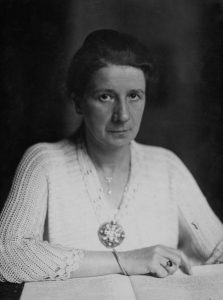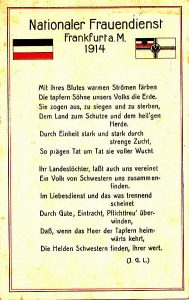The National Women’s Service (Nationaler Frauendienst, NFD) (1914-1918)
“The Frauendienst was viewed as more than simply another women’s organization; it was a national defense effort” – Historian C.E. Boyd
The National Women’s Service (Nationaler Frauendienst, NFD) was coordinating female war support in Imperial Germany during World War I. Initiated in August 1914 by Gertrud Bäumer (1873-1954), since 1910 leader of the Federation of German Women’s Associations (Bund Deutscher Frauenvereine, BDF), an umbrella organization of the middle- and upper-class women’s movement, founded in 1894, the NFD was a combined effort of hundred-thousands of women to bring aid to those whose homes and lives were affected by the war. The war support at the “home front” became necessary during the First World War because Imperial Germany, like all other belligerents, fought an industrialized “total war,” which was not possible without the large-scale mobilization of the civilians, women and men, for the war efforts, who in turn became targets of warfare, for example by economic blockade, which aimed the break the sprit at the home front and with it disrupt its war support.
The NFD was not only supported by the leaders of the many liberal and conservative middle- and upper-class women’s associations of the BDF, but also by the female leader of the free German trade unions and the Social Democratic Party of Germany (SPD). They followed the majority of the SPD in the Reichstag, which had despite its pre-war opposition against any war in the end supported the German Emperors declaration of war, because it believed the propaganda of a “defense war.” For the first time in German history, social democratic, liberal and conservative women officially cooperated on a national level in the NFD. Before the new umbrella organization could start its work in August 1914, its leaders had in every community to request permission for the creation of a union of all present women’s organizations in the town or city.
The women who worked in the NFD were motivated by enthusiasm, patriotism and nationalism, sentiments shared by many Germans at the beginning of World War I. The NFD was intended to boost morale on the home front while providing practical assistance to those in need as a result of the war. It offered hundred-thousands of women an opportunity for the involvement in war support. Many activists in the NFD, especially social democratic women, hoped that their war support at the home front, would be recognized as of equal importance for the war success as the military service of the men at the front lines and would therefore lead after the victory to equal or even universal suffrage with men.
Although active only at the home front, the NFD made indeed enormous contributions to the German war effort, cooperating closely on the national and local level with the government and the Red Cross, which was responsible for the military medical care. The NFD organized war welfare for the families of soldiers, for war widows and orphans and for invalid veterans. It provided food and shelter to refugees and opened maternity homes for expecting mothers whose husbands had been conscripted. Furthermore, it organized school lunches for hungry school children, soup kitchen for impoverished working- and middle-class families and childcare for the growing number of working mothers. It also informed housewives how to deal with the decreasing, rationed food supply in their kitchens and offered “war cooking courses.” Finally, the NFD also helped the government to organize the increasingly needed female work in war industries, were women replaces the conscripted men. After bearing witness to the NFD’s successful work, the German government put the organization in charge of the Imperial Maternity Support Bill (Reichswochenhilfe), which granted support to pregnant women whose husbands had been drafted amidst concern over Germany’s falling birthrate. The volunteers supported expecting mothers financially, and even took care of them: providing doctors, post-natal care, and opening maternity homes.
The National Women’s Service of Germany demonstrates the extent to which German women supported the home front during World War I. There is a lot of emphasis placed on the women who engaged in combat or other ‘risky’ tasks like espionage, which is well-deserved. However, almost no information is shared on the thousands of volunteers who supported the individuals affected by the war. More recognition is needed for work like this: providing homes and free meals for refugees and financially supporting military dependents and orphans. Still today, just because a wartime contribution isn’t as dangerous as combat doesn’t mean it isn’t just as essential.
Rachel Arenas, Exercise and Sports Science, Class of 2021
Sources
Literature and Websites
- Boyd, C.E. “‘Nationaler Frauendienst’: German Middle-Class Women in Service to the Fatherland, 1914-1918.” (PhD diss., University of Georgia, 1979), 54-99.
- Stibbe, Mathew, “Women’s Mobilization for War-Germany.” International Encyclopedia of the First World War: 1914-1918 Online, at: https://encyclopedia.1914-1918-online.net/article/womens_mobilisation_for_war_germany (Accessed, 20 April 2018)
Images
- Image 1: Source: http://www.bpb.de/gesellschaft/gender/frauenbewegung/35261/erster-weltkrieg
- Image 2: Source: https://www.in-die-zukunft-gedacht.de/de/page/84/thema/135/dokument/720/themen.html
- Image 3: Source: Wikimedia


